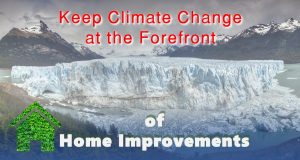There is ample data today cataloging the temperatures across North America over approximately the past century. Climate change is here, and we need to do something. And that data clearly indicates that on average the U.S. is getting warmer, creating some expected as well as some surprising hot spots which indicate 2 degrees Celsius warming and more.
The Northeast region is one that is warming faster, where the long coastline is in greatest danger and with local hot pockets around Philadelphia and central and coastal New Jersey, among others.
These facts should motivate area residents to prioritize the environment and personal health as they plan each home improvement, finding the best ways to minimize their climate impact. The eco-friendly and sustainable marketplace is rich with options.
Begin by using sustainable materials and designs.
Many building materials, furniture, and appointments are made with recycled materials as well as items repurposed from previous uses like lumber or other household items.
Gardens are ideal places for reusing many things such as bricks or concrete for borders, tires painted and used as planters, and even discarded cabinets or shelving for decorative but functional plant display.
Include composting in lawn and garden designs, and eliminate the use of hazardous materials everywhere around the house.
Always keep energy efficiency in mind.
When renovating or adding space, make sure to insulate and seal, and find modern and efficient doors and windows built for thermal insulation through both summer and winter.
Use modern lighting such as CFLs or LEDs to save 20% or more of your electricity usage, starting with the most used lamps and fixtures in the home.
When expanding or upgrading, install efficient HVAC units that include smart thermostats, and create individual cooling and heating zones that suit your house and lifestyle.
Consider solar energy and electric vehicles (EV).
Transportation and electricity generation produce the majority of climate impacting emissions, and every personal and family effort to reduce matters. Each solar home reduces utility emissions by the amount of solar electricity generated locally, whether that power is used immediately within the home, or if it is sent back to the grid.
When mated to a home solar energy system, EV owners have the highest control in reducing tailpipe emissions, and when ensuring the car is charging with clean energy as much as possible, they further reduce utility emissions.
These ideas are just a limited few of the many ways we can improve and upgrade our homes to increase our comfort and contentment while also making us better stewards of our collective environment.
Learn more about Combining Solar Energy & EV Charging.

